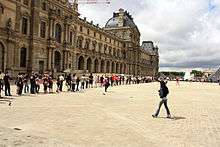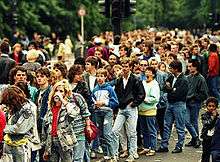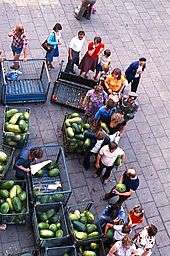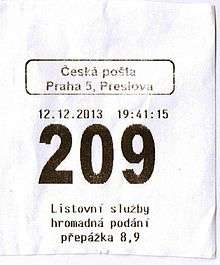Queue area

Queue areas are places in which people queue (first-come, first-served) for goods or services. Such a group of people is known as a queue (British usage) or line (American usage), and the people are said to be waiting or standing in a queue or in line, respectively. (In the New York City area, the phrase on line is often used in place of in line.)[1]
Examples include checking out groceries or other goods that have been collected in a self service shop, in a shop without self-service, at an ATM, at a ticket desk, a city bus, or in a taxi stand.
Queueing[2] is a phenomenon in a number of fields, and has been extensively analysed in the study of queueing theory.
In economics, queueing is seen as one way to ration scarce goods and services.
Types of queues
Physical queue


Organized queue areas are commonly found at amusement parks. The rides have a fixed number of guests that can be served at any given time, so there has to be some control over additional guests who are waiting. This led to the development of formalized queue areas—areas in which the lines of people waiting to board the rides are organized by railings, and may be given shelter from the elements with a roof over their heads, inside a climate-controlled building or with fans and misting devices. In some amusement parks – Disney Parks being a prime example – queue areas can be elaborately decorated, with holding areas fostering anticipation, thus shortening the perceived wait for people in the queue by giving them something interesting to look at as they wait, or the perception that they have arrived at the threshold of the attraction.
Queues can be found in railway stations to book tickets, at bus stops for boarding and at temples as well.[3][4][5]
Queues are generally found at transportation terminals where security screenings are conducted.
Large stores and supermarkets may have dozens of separate queues, but this can cause frustration, as different lines tend to be handled at different speeds; some people are served quickly, while others may wait for longer periods of time. Sometimes two people who are together split up and each waits in a different line; once it is determined which line is faster, the one in the slower line joins the other. Another arrangement is for everyone to wait in a single line; a person leaves the line each time a service point opens up. This is a common setup in banks and post offices.
Historical perspective of line formation
At the beginning of the Common Era, people attending events simply gathered in mass, clustered and clumped together in an unorganised manner. After several thousand years of this they slowly gravitated to the back of individual fellows, and began to stand behind one another in a horizontal fashion, forming what is now colloquially referred to as "The Line".
Virtual queue

Physical queueing is sometimes replaced by virtual queueing. In a waiting room there may be a system whereby the queuer asks and remembers where his place is in the queue, or reports to a desk and signs in, or takes a ticket with a number from a machine. These queues typically are found at doctors' offices, hospitals, town halls, social security offices, labor exchanges, the Department of Motor Vehicles, the immigration departments, free internet access in the state or council libraries, banks or post offices and call centres. Especially in the United Kingdom, tickets are taken to form a virtual queue at delicatessens and children's shoe shops. In some countries such as Sweden, virtual queues are also common in shops and railway stations. A display sometimes shows the number that was last called for service.
Restaurants have come to employ virtual queueing techniques with the availability of application-specific pagers, which alert those waiting that they should report to the host to be seated. Another option used at restaurants is to assign customers a confirmed return time, basically a reservation issued on arrival.
Virtual queueing apps are available that allow the customers to view the virtual queue status of a business and they can take virtual queue numbers remotely. The app can be used to get updates of the virtual queue status that the customer is in. Apps such as NoWait[6] and Q2U[7] are examples of how queues are managed virtually.
Mobile queue
All of the above methods, however, suffer from the same drawback: the person arrives at the location only to find out that they need to wait. Recently, queues at DMVs,[8] colleges, restaurants,[9] healthcare institutions,[10] government offices[9] and elsewhere have begun to be replaced by mobile queues or queue-ahead, whereby the person queueing uses his/her phone, the internet, a kiosk or another method to enter a virtual queue, optionally prior to arrival, is free to roam during the wait, and then gets paged at his/her mobile phone when his/her turn approaches. This has the advantage of allowing users to find out the wait forecast and get in the queue before arriving, roaming freely and then timing their arrival to the availability of service. This has been shown to extend the patience of those in the queue and reduce no-shows.[9] Mobile queueing (see also QLess Q2U) is more environmentally friendly than application-specific pagers, which require special-purpose batteries and hardware, and healthier from a public health perspective, as there is no shared device changing hands.

Physical queue design
When designing queues, planners attempt to make the wait as pleasant and as simple as possible. They employ several strategies to achieve this, including:
- Expanding the capacity of the queue, thus allowing more patrons to have a place. This can be achieved by:
- Increasing the length of the queue by making the queue longer
- Increasing the size of the lanes within the queue
- Increasing the length of the queue by designing the line in a "zig-zag" shape that holds a large amount of guests in a smaller area. This is used often at amusement parks. Notable rides have a large area of this kind of line to hold as many people as possible in line. Portions of the line can be sectioned off and bypassed by guests if the queue is not crowded.
- "In-line" entertainment can be added. This is popular at amusement parks like Walt Disney World, which uses TV screens and other visuals to keep people in the queue area occupied.
- Secondary queue areas for patrons with special tickets, like the FASTPASS system used at Disney parks, or the Q-bot as used in Legoland Windsor.
Using substitution in virtual queues
Before implementing a virtual queue, some thought should be given to the availability of substitutes. A substitute, in this context, is an alternative activity the queuer can participate in rather than standing in line. Ideally the substitute activity should be aligned with the objectives of both the queuer and the organisation where the queue forms. Providing a substitute activity for the queuer can be an effective approach for reducing perceived waiting time.
In a busy restaurant, a good substitute for a waiting customer would be a bar. At an outdoor attraction with long queues, a good substitute might be a side marquee selling merchandise or food.
A good substitute will:
- Put the customer at ease allowing them to do something more interesting than standing in line
- Increase the customer's tolerance level for waiting
- Provide the organisation with an opportunity to generate additional revenue from the waiting customers
- Tether the customer to the organisation making it less likely that the customer aborts their visit because of a long queue
Providing a well thought through substitute activity that complements the main product or service being queued for, can provide an organisation with a valuable customer service advantage.[11]
See also
References
- ↑ LearnersDictionary.com
- ↑ Also spelled queuing. askoxford.com. Retrieved 2009-4-29.
- ↑ "Queues get longer at railway station". The Hindu. Mangalore. 3 May 2012. Retrieved Mar 2, 2015.
- ↑ "Many bus stops in Mumbai not in 'BEST' shape". Daily News and Analysis. Mumbai. 28 May 2011. Retrieved Mar 2, 2015.
- ↑ "Shirdi: Now, pay extra for VIP 'aartis' at Sai Baba temple". NDTV. Shirdi. 17 November 2013. Retrieved Mar 2, 2015.
- ↑ http://nowait.com
- ↑ https://www.q2u.com.au
- ↑ DMV’s New Line Management System is Available Online Archived July 26, 2011, at the Wayback Machine..
- 1 2 3 "Exit waiting in line, enter QLess". Vator.tv. 2010-01-14. Retrieved 2010-09-23.
- ↑ "Could your practice's waiting area become obsolete? : Noteworthy – A Family Practice Management blog". Blogs.aafp.org. Retrieved 2010-09-23.
- ↑ Supalocal, "Master the art of substitution", April 12, 2011, accessed July 11, 2011.
- Maister, D.H. (1988). Managing Services: Marketing, Operations and Human Resources. Prentice-Hall.
- Mercer, David. Redefining marketing in the multi-channel age. Wiley.
External links
| Wikimedia Commons has media related to Queues. |
- For insight into the British habit of queueing, see standinaqueue